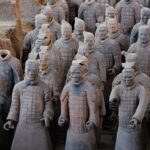Inside Unit 731: Japan’s Biological Weapons Program

During World War II, the Japanese military carried out horrific medical experiments on thousands of Chinese, Russian, Korean, and Mongolian prisoners. This top secret program went by the name of “Unit 731”. At huge complexes in Japanese-occupied China, Unit 731’s doctors and researchers committed barbaric atrocities in the name of science and biological warfare.
Unit 731 operated between 1937-1945 in the region of Manchuria. Its stated goal was to conduct research into epidemics and develop biological weapons for the Japanese military. The sites included purpose-built prisons and laboratory facilities where thousands of men, women, and children were subjected to agonizing experiments, then killed and dissected. Most of the victims were Chinese civilians and soldiers.
After the war ended, the researchers got off free – they even went on to have prestigious careers. The gruesome details of their “experiments” went unknown for decades. But history deserves to know the full truth about the shocking cruelty that occurred inside Unit 731.

Freezing Test Subjects to Study Frostbite
One Japanese doctor named Yoshimura Hisato specialized in frostbite experiments. His test subjects were Chinese and Russian prisoners. During Manchuria’s extremely harsh winters, the captives were taken outside into subzero conditions while lightly clothed until their arms or legs completely froze solid. Some even had ice crystals form over their skin. The frozen flesh would make a wooden sound when struck.
Hisato focused on studying different rapid rewarming techniques to treat frostbite. Some prisoners had their frozen limbs doused in boiling water or held close to an open flame. Others were left untreated overnight so their own blood circulation could slowly thaw the limb. This torturous experiment left many with permanent nerve damage or crippled limbs from severe frostbite injuries. If gangrene set in, doctors would amputate the decaying arm or leg just to continue monitoring their subject.
Dissecting Living Bodies Without Anesthesia
Thousands of Chinese civilians and soldiers suffered through “vivisection” – the dissection of live subjects without anesthesia. Unit 731’s surgeons cut open their organs just to examine the effects of diseases inside a living body. The subjects’ howls of pain went ignored while doctors clinically took notes. Children, pregnant women, and the elderly were not spared from the vivisections.
After being infected with cholera, bubonic plague, syphilis, or other pathogens, prisoners also underwent amputations or had limbs reattached on the opposite side. Their flesh was frozen, burned, gashed with bayonets, blasted with X-Rays, and more – all without pain relief medication. If by some miracle a mutilated subject survived, they would soon be killed then autopsied anyway.
Testing Gruesome Weapons On Living Targets
Beyond medical research, Unit 731 conducted field tests on Japanese military weapons. Prisoners were tied to wooden posts or stakes while soldiers practiced bayonet charges at them. The doctors would observe and take notes on the war wounds inflicted. Survivors were then vivisected so surgeons could compare the internal organ damage with exterior wound patterns.
Human captives were also used to test grenades, flamethrowers, chemical weapons, bombs with shrapnel, and high-pressure chambers. For gun target practice, prisoners would be lined up or staked downrange while researchers fired Nambu pistols, rifles, and machine guns to compare bullet performance. After the test, lifeless bodies were dissected and bullets were matched to wounds.
Breeding Virulent Strains of Plague for Biowarfare
While death awaited all who entered Unit 731’s compounds, the cruelest experiments were saved for Chinese civilians in nearby villages. Unit 731 bred typhus, anthrax, cholera, and bubonic plague pathogens to use as biological weapons. To cultivate the most deadly disease strains, doctors performed “passage” experiments on prisoners.
In passage testing, an initial group of captives would be infected with a pathogen, with no treatment given. When they fell critically ill, researchers would bleed them out alive to extract blood saturated with billions of infectious germs. That contaminated blood would be injected into the next round of subjects, then repeated to concentrate the bacteria or virus strain over successive generations.

Spreading Plague-infested Fleas on Chinese Towns
After breeding hyper-lethal microbes, Unit 731 conducted field tests by dropping “flea bombs” on unsuspecting towns. The bombs unleashed vast clouds of plague-transmitting fleas that had fed on germ-infected prisoners. In October 1940 and again in 1941, Unit 731 planes bombed the towns of Quzhou, Ningbo, and Changde – killing over 2,000 Chinese civilians in epidemics. They planned similar attacks on U.S. cities with “balloon bombs” loaded with plague-carrying rats and fleas, but Japan surrendered first in 1945.
Legacy of Brutality With Zero Accountability
At least 3,000 prisoners are believed to have died from Unit 731’s experiments overall, but the true death toll is unknown. Almost all of their records were destroyed in 1945 as American forces closed in. Under a veil of secrecy, the United States granted Unit 731’s doctors and commanders immunity from war crimes trials in exchange for all their medical data.
Without even an apology, Japan’s butchers were free to melt back into society after the war. A number of Unit 731 alumni even rose to prominence in medicine, pharmacology, and academia. Some perpetrators lived into the 1990s while their victims’ graves remain untended and forgotten. The full truth about their torture may never come to light.
Deeper Descent into Depravity
As if the cruel experiments were not enough, Unit 731 plumbed even greater depths of depravity. Prisoners found themselves victims of sexual violence in the name of “scientific research.”
Spreading Syphilis Through Rape
Doctors deliberately infected many captives with syphilis to monitor the infection’s progression. Male prisoners were ordered to rape female prisoners to ensure transmission of the disease, which would be tracked by researchers. If the first exposure failed to infect initially, the women were raped repeatedly until the syphilis successfully took hold. The women endured excruciating pain, fever, and mental anguish as their bodies deteriorated from advanced syphilis.
Impregnating Women Only to Kill Them
Female subjects of childbearing age were especially valued for experimentation. Many endured forcible impregnation so weapon and trauma testing could be conducted on them while pregnant. After the women prisoners gave “birth,” their newborn babies were generally killed immediately.
The grieving mothers also faced a gruesome demise – death by vivisection, lethal injection, or disease. Almost none survived Unit 731’s laboratories once pregnant. The shocking practice provided data on how weapons and infections affected fetuses.
Legacies of Secrecy
To this day, Japan refuses to fully acknowledge or apologize for Unit 731’s obscene crimes against humanity. China estimates at least 250,000 of its civilians died from Japan’s biological weapons in World War 2. The sprawling facility ruins have become memorials, graveyards, and sobering museums near Harbin city in Manchuria.
Many descendants of Japanese war criminals went on to become doctors, hospital administrators, and medical school professors. As both sides kept silent, Unit 731’s horrific secrets stayed buried for over 50 years after WW2. But calls persist for Japan to admit and teach its youth about this dark chapter of medical ethics violations. China and Korea’s demands for compensation have gone unheeded as more victims succumb to old age each year.
While Imperial Japan inflicted tremendous suffering in Unit 731, its murderous human experiments also left lasting scars on the conscience of science and medicine everywhere. Unfathomable as such brutality seems, it serves as a cautionary lesson in medical ethics for current and future generations.







